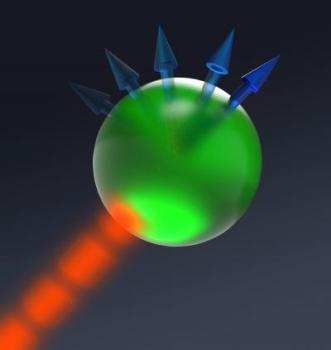May 2 2013
By using light, researchers at UC Santa Barbara have manipulated the quantum state of a single atomic-sized defect in diamond –– the nitrogen-vacancy center –– in a method that not only allows for more unified control than conventional processes, but is more versatile, and opens up the possibility of exploring new solid-state quantum systems. Their results are published in the latest edition of the Proceedings of the National Academy of the Sciences.
 This is an artist's rendering of all-optical control of an individual electronic spin within a diamond. This spin is associated with a naturally occurring defect in diamond known as the nitrogen-vacancy center, a promising quantum bit (qubit) for quantum information processing. In their recently published paper, Yale et al. develop techniques to initialize, manipulate, and read out the electronic spin of this qubit using only pulses of light. Credit: Peter Allen
This is an artist's rendering of all-optical control of an individual electronic spin within a diamond. This spin is associated with a naturally occurring defect in diamond known as the nitrogen-vacancy center, a promising quantum bit (qubit) for quantum information processing. In their recently published paper, Yale et al. develop techniques to initialize, manipulate, and read out the electronic spin of this qubit using only pulses of light. Credit: Peter Allen
"In contrast to conventional electronics, we developed an all-optical scheme for controlling individual quantum bits in semiconductors using pulses of light," said David Awschalom, director of UCSB's Center for Spintronics & Quantum Computation, professor of physics and of electrical and computer engineering, and the Peter J. Clarke director of the California NanoSystems Institute. "This finding offers an intriguing opportunity for processing and communicating quantum information with photonic chips."
The nitrogen-vacancy (NV) center is a defect in the atomic structure of a diamond where one carbon atom in the diamond lattice is replaced by a nitrogen atom, and an adjacent site in the lattice is vacant. The resulting electronic spin around the defect forms a quantum bit –– "qubit" –– which is the basic unit of a quantum computer. Current processes require this qubit be initialized into a well-defined energy state before interfacing with it. Unlike classical computers, where the basic unit of information, the bit, is either 0 or 1, qubits can be 0, 1, or any mathematical superposition of both, allowing for more complex operations.
"The initial problem we were trying to solve was to figure out a way that we could place our qubit into any possible superposition of its state in a single step," said the paper's first author, physics graduate student Christopher Yale. "It turns out that in addition to being able to do that just by adjusting the laser light interacting with our spin, we discovered that we could generate coherent rotations of that spin state and read out its state relative to any other state of our choosing using only optical processes."
The all-optical control allows for greater versatility in manipulating the NV center over disparate conventional methods that use microwave fields and exploit defect-specific properties. While the NV center in diamond is a promising qubit that has been studied extensively for the past decade, diamonds are challenging to engineer and grow. This all-optical methodology, say the researchers, may allow for the exploration of quantum systems in other materials that are more technologically mature. "Compared to how the NV center is usually studied, these techniques in some ways are more general and could potentially enable the study of unexplored quantum systems," said UCSB physics graduate student Bob Buckley.
Additionally, the all-optical method also has the potential to be more scalable, noted physics graduate student David Christle. "If you have an array of these qubits in order, and if you're applying conventional microwave fields, it becomes difficult to talk to one of them without talking to the others. In principle, with our technique in an idealized optical system, you would be able focus the light down onto a single qubit and only talk to it."
While practical quantum computers are still years and years away, the research opens up new paths toward their eventual creation. According to the group, these devices would be capable of performing certain sophisticated calculations and functions far more efficiently than today's computers can –– leading to advances in fields as diverse as encryption and quantum simulation.
UCSB electrical and computer engineering graduate student F. Joseph Heremans and postdoctoral researcher Lee Bassett also contributed to this study. Additional theoretical work and insight was provided by Guido Burkard, professor of physics at the University of Konstanz, Germany.